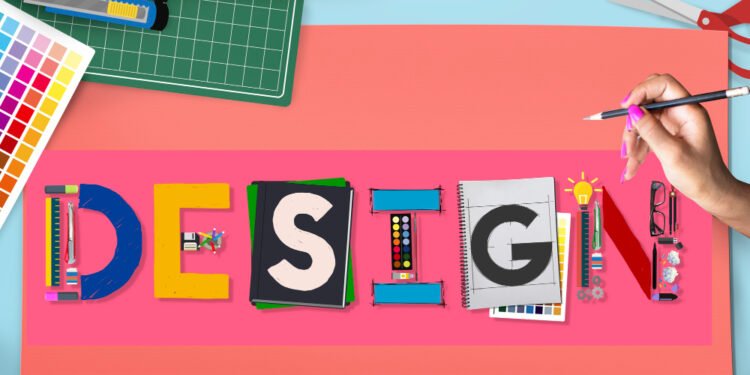What role does text design play in capturing the audience’s attention and conveying the message effectively? The answer lies in the combination of typography, graphic design, and layout. As we delve into the world of text design, we will explore how these elements work together to create visually appealing and engaging content.
In the realm of visual communication, text design is a crucial aspect that can make or break the message. With the help of advanced techniques and tools, designers can now create stunning text designs that elevate the content and capture the audience’s attention. From font pairing to layout, every element plays a significant role in creating an effective text design.
Key Takeaways
- Text design is a critical aspect of visual communication that can make or break the message.
- Typography plays a significant role in text design, and font pairing is essential for creating visually appealing content.
- Graphic design and layout are also crucial elements of text design that can enhance the message and capture the audience’s attention.
- Advanced techniques and tools, such as transformer-based models, can help designers create stunning text designs.
- Effective text design can save time and effort when dealing with large volumes of text and facilitate better decision-making.
- Text design is not just about aesthetics; it’s also about creating engaging and readable content that resonates with the audience.
What is Text Design?
Text design is the process of selecting and arranging typefaces, point sizes, line lengths, and other elements to communicate a message. It involves creating a visual hierarchy, using font pairing, and considering the layout to engage the audience. A well-designed text can increase user engagement, potentially extending the time a user spends on a website.
Good typography is essential in text design, as it can influence decision-making and create a lasting impression. The use of font pairing, layout, and visual hierarchy can make or break the effectiveness of a text design. By understanding these elements, designers can create effective text designs that convey the message and engage the audience.
Establishing a typographical hierarchy is necessary for directing how users consume content quickly. The typical number of fonts recommended for use in a user interface design is no more than three, and consistency among typefaces is crucial to prevent confusion. By applying these principles, designers can create text designs that are both visually appealing and effective in communicating the message.
Definition and Importance
Text design has a rich history, dating back to the 11th century. The Gutenberg Bible represents one of the first large-scale examples of typography and was pivotal in the development of modern typography. Today, typography is predominantly associated with digital design, and its importance cannot be overstated.
Historical Context
The evolution of text design has been shaped by technological advancements and changing design trends. From the early days of printing to the modern digital era, text design has played a crucial role in communicating messages and engaging audiences.
Key Elements of Text Design
The key elements of text design include font pairing, layout, and visual hierarchy. By understanding and applying these elements, designers can create effective text designs that convey the message and engage the audience. A well-designed text can increase user engagement, potentially extending the time a user spends on a website, and ultimately driving business results.
Principles of Effective Text Design
Effective text design is crucial for clear communication, branding, and web design. It involves creating a visual hierarchy, balance, and alignment to guide the reader’s attention. A well-designed text should be easy to read, understand, and navigate.
Balance and alignment are essential principles of text design. They help create a visually appealing layout that engages the reader. Proper use of whitespace, margins, and line spacing can enhance readability and legibility. In web design, a balanced layout can improve user experience and encourage visitors to stay on the page.
Balance and Alignment
In text design, balance refers to the distribution of visual elements, such as text, images, and whitespace. Alignment, on the other hand, refers to the placement of text and other elements in relation to each other. Proper alignment can create a sense of order and harmony, making the text more readable and accessible.
Hierarchy and Contrast
Hierarchy and contrast are also critical principles of text design. They help create a visual flow, guiding the reader’s attention through the content. In branding, a clear hierarchy and contrast can reinforce the brand’s message and identity. In web design, a well-structured hierarchy can improve navigation and user experience.
By applying these principles of effective text design, designers can create engaging, readable, and accessible content that communicates the message effectively. Whether it’s for web design, branding, or communication, good text design is essential for capturing the audience’s attention and conveying the intended message.
Typography in Text Design
Typography plays a crucial role in text design, as it can greatly impact the overall aesthetic and readability of a piece. When it comes to typography, selecting the right fonts is essential. The process of font pairing can be complex, but it is a vital aspect of graphic design. A good rule of thumb is to use no more than three typefaces in a design, with two often being sufficient.
Understanding font families is also important, as different families can evoke different emotions and convey different messages. For example, serif fonts are often preferred for print publications, while sans serif fonts can improve readability on digital screens. Display fonts, on the other hand, are effective for headers and titles, with many graphic designers recommending their use.
Using typography for emotion is a powerful tool in text design. The right font can convey a sense of sophistication, elegance, or playfulness, depending on the desired tone. By carefully selecting and pairing fonts, designers can create a visual hierarchy that guides the reader’s eye and enhances the overall message. With 75% of consumers judging the credibility of a brand based on its typography, it’s clear that typography is a critical aspect of graphic design and text design.
Selecting the Right Fonts
When selecting fonts, it’s essential to consider the optimal range for line length, font size, and line height. The recommended font size for website text is between 16-20 px, with a line height of 120-170% for optimal readability. By following these guidelines and using typography effectively, designers can create text designs that are both visually appealing and engaging.
The Role of Color in Text Design
Color plays a crucial role in text design, as it can greatly affect the audience’s perception and engagement. The psychological impacts of color are significant, and choosing a color palette that communicates the message effectively is essential. In web design, color is used to create a visual hierarchy, guiding the reader’s attention through the content. Effective communication is key, and color can either enhance or hinder this process.
When selecting a color palette, it’s essential to consider the contrast between the text and background. A minimum contrast ratio of 4.5:1 for normal text and 3:1 for large text is recommended. This ensures that the text is readable and accessible for all audiences. In visual hierarchy, color can be used to create a clear structure, making it easier for readers to navigate the content.
In web design, the effective use of color can improve comprehension and retention of information by up to 73%. Consistent text color usage across all touchpoints can also improve brand recognition by as much as 23%. By considering the psychological impacts of color and creating a well-structured visual hierarchy, designers can create text designs that communicate effectively and engage their audience.
Layout Techniques for Text Design
Effective layout techniques are crucial in graphic design, as they guide the audience’s attention and create a clear visual flow. A well-designed layout can significantly improve the chances that your content will be read, with improper layout leading to up to a 70% chance of information being overlooked. In the context of font pairing and layout, it is essential to balance text and visuals to engage the audience and communicate the message effectively.
The use of grid systems and structures is a fundamental aspect of layout techniques. Grids help to organize content, providing a sense of proportion and order. Newspapers frequently utilize a modular grid, which consists of multiple columns and rows, for diverse content organization. Column grids are commonly employed by magazines due to their ability to enhance readability and provide a sense of proportion and order. By applying these grid systems, designers can create a harmonious and balanced layout that supports their graphic design and font pairing choices.
White space utilization is another critical aspect of layout techniques. The use of white space, when applied wisely, can lead to a 30% increase in reader engagement by making content feel less cluttered. In addition to grid systems and white space utilization, visual flow and hierarchy are essential in creating a clear and effective layout. By understanding these techniques, designers can create text designs that engage the audience and communicate the message effectively, ultimately enhancing the overall graphic design and layout of the content.
Tools for Creating Text Designs
When it comes to creating text designs, having the right tools is essential. In the context of web design, communication, and branding, the tools used can make a significant difference in the outcome. Professional software options, such as Adobe Creative Cloud, offer a wide range of features and benefits for designers.
In addition to professional software, there are many online tools available for simplified design. These tools can be useful for those who are new to text design or who need to create a design quickly. Some online tools also offer free resources, such as fonts and templates, which can be useful for designers.
Software Options: Adobe and Beyond
Adobe Creative Cloud is a popular choice among designers, offering a range of software options, including Photoshop and Illustrator. These programs provide advanced features and tools for creating complex text designs.
Online Tools for Simplified Design
For those who are new to text design or who need to create a design quickly, online tools can be a great option. These tools often offer a user-friendly interface and a range of templates and fonts to choose from.
Free Resources Worth Exploring
In addition to paid software and online tools, there are many free resources available for designers. These resources can include fonts, templates, and tutorials, which can be useful for creating text designs for web design, communication, and branding purposes.
Text Design in Branding
Effective branding relies heavily on consistent visual elements, including text design. A well-crafted text design can elevate a brand’s identity and make it more recognizable. In the context of branding, graphic design plays a crucial role in creating a cohesive visual language. Font pairing, in particular, can significantly impact the overall aesthetic and tone of a brand.
Consistency across platforms is essential for building a strong brand identity. This includes using the same font styles, sizes, and colors across all marketing materials, websites, and social media channels. A consistent text design helps to create a sense of familiarity and recognition among customers. For instance, brands like Coca Cola and eBay have successfully utilized text logos to create a distinctive brand identity.
Building brand identity through text design involves careful consideration of typography, color, and layout. A good text design should be legible, readable, and visually appealing. The use of negative space, as seen in the FedEx logo, can also add an extra layer of depth and meaning to a text design. By incorporating these elements, businesses can create a unique and recognizable brand identity that resonates with their target audience.
Successful branding often involves a combination of simplicity and creativity. Handwritten logo designs, monogram logos, and custom typography can all contribute to a distinctive brand identity. With the help of creation tools like DesignCrowd and BrandCrowd, businesses can generate custom text designs that reflect their brand’s values and personality. By investing in a well-designed text design, companies can establish a strong foundation for their brand and differentiate themselves in a competitive market.
Web Design and Text Design
When it comes to web design, text design plays a crucial role in creating a visually appealing and user-friendly experience. Effective web design requires a deep understanding of how to balance communication, visual hierarchy, and accessibility considerations. A well-designed text can guide the user’s attention, convey the message, and create a lasting impression.
In the context of web design, responsive text design is essential to ensure that the text adapts to different screen sizes and devices. This involves using flexible font sizes, line heights, and margins to create a seamless reading experience. By incorporating web design principles, such as visual hierarchy and communication, designers can create text designs that are both aesthetically pleasing and functional.
Search engine optimization (SEO) is also a critical aspect of text design in web design. By optimizing the text for search engines, designers can improve the website’s visibility and ranking. This involves using relevant keywords, such as web design and communication, to create a keyword-rich text that is both informative and engaging. Additionally, designers must consider accessibility considerations, such as font size, color contrast, and readability, to ensure that the text is accessible to all audiences.
Responsive Text Design
Responsive text design involves creating text that adapts to different screen sizes and devices. This requires a deep understanding of how to use flexible font sizes, line heights, and margins to create a seamless reading experience. By incorporating web design principles, such as visual hierarchy and communication, designers can create text designs that are both aesthetically pleasing and functional.
SEO and Text Design
SEO is a critical aspect of text design in web design. By optimizing the text for search engines, designers can improve the website’s visibility and ranking. This involves using relevant keywords, such as web design and communication, to create a keyword-rich text that is both informative and engaging.
Accessibility Considerations
Accessibility considerations are essential in text design to ensure that the text is readable and accessible to all audiences. This involves using font sizes, color contrast, and readability guidelines to create a text design that is both aesthetically pleasing and functional. By incorporating web design principles, such as visual hierarchy and communication, designers can create text designs that are both accessible and engaging.
Print vs. Digital Text Design
When it comes to text design, the approach differs significantly between print and digital mediums. In print design, the layout and font pairing are crucial to capture the audience’s attention, as the design is static and cannot be altered once produced. On the other hand, digital designs offer flexibility in formatting and can be easily modified post-creation.
In graphic design, the choice of font pairing and layout is critical to convey the message effectively. For print designs, designers need to consider the fixed dimensions and color modes, such as CMYK, to ensure high-quality output. In contrast, digital designs use RGB or HEX formats for colors and require consideration of screen sizes and resolutions.
Understanding the differences between print and digital text design is essential for designers to create effective and engaging designs. By considering the unique characteristics of each medium, designers can create layouts and font pairings that enhance the user experience and communicate the message effectively.
Incorporating Images and Graphics
When it comes to effective communication in web design, incorporating images and graphics is crucial. A visual hierarchy helps to organize content and guide the user’s attention. With 90% of information transmitted to the brain being visual, it’s clear that images play a significant role in conveying messages and engaging audiences. The use of images and graphics can enhance the communication process, making it more efficient and effective.
Studies have shown that infographics can improve comprehension by up to 80%, making complex data more digestible for users. Moreover, users spend an average of 10% more time on web pages that include relevant visuals compared to those without. This highlights the importance of incorporating images and graphics into web design to capture and retain user attention.
Enhancing Messaging with Graphics
Graphics can be used to convey complex information in a simple and easy-to-understand format. By using images and graphics, designers can create a visual hierarchy that guides the user’s attention and enhances the overall communication process. With the right web design strategy, businesses can increase engagement, improve comprehension, and convey their message more effectively.
Trends in Text Design
Text design is constantly evolving, with new trends and technologies emerging every year. In recent years, there has been a shift towards bold and vibrant typography, with many designers incorporating bright colors and unique font styles into their work. This trend is reflected in the use of graphic design elements, such as font pairing and layout, to create visually striking text designs.
One ofappa the key trends in text design is the use of variable fonts, which allow for multiple variations of a typeface within a single font file. This improves website performance by reducing the number of font files needed. Another trend is the resurgence of serif fonts, which are often used in industries such as finance and law to evoke a sense of tradition and reliability. The use of custom fonts is also becoming increasingly popular, as brands look to differentiate themselves in a crowded market.
In terms of layout,lrt there is a trend towards minimalist maximalism, which combines simplicity with bold visuals. This involves using ample white space and clear typography alongside intricate patterns and intense colors. Dynamic branding and personalization are also becoming more important, with many companies using imagery and layout adjustments based on user preferences and behavior. By incorporating these trends into their text design, companies can create a more engaging and effective user experience.
Current Trends in Typography
Some of the current trends in typography include the use of bold sans-serif fonts for headers and clean serif fonts for body text. This combination has been shown to increase engagement metrics by 48%. Oversized typography is also being used effectively in digital platforms, with 63% of platforms using it for key messages or branding elements. By staying up-to-date with the latest trends and technologies, designers can create text designs that are both visually striking and effective.
Conclusion: The Future of Text Design
As we reach the conclusion of our exploration of text design, it’s essential to reflect on the evolving technologies and methods that will shape the field’s future. The web design industry is continuously advancing, and designers must stay adaptable to ensure their text designs remain effective and engaging.
Evolving Technologies and Methods
The rise of headless design systems is a prime example of the technological shifts impacting text design. These innovative systems offer increased scalability and efficiency compared to traditional approaches, enabling designers to create more dynamic and configurable content. Additionally, the integration of artificial intelligence into design tools promises to streamline various processes, from token generation to accessibility compliance.
Lifelong Learning in Text Design
Embracing the future of text design will require a commitment to lifelong learning. As the industry evolves, designers must be proactive in staying up-to-date with the latest web design trends, communication best practices, and branding strategies. Continuous skill development and a willingness to adapt will be essential for designers to thrive in this rapidly changing landscape.
Final Thoughts on Embracing Text Design
In conclusion, the future of text design is bright and full of potential. By understanding the evolving technologies and methods, as well as committing to lifelong learning, designers can position themselves at the forefront of this dynamic field. Effective text design will continue to be a crucial component of compelling web design, impactful communication, and strong branding. As we move forward, embrace the power of text design and unlock new possibilities for visual storytelling.
FAQ
What is the definition and importance of text design?
Text design is the art of arranging and presenting written content in a visually appealing and effective manner. It is a crucial aspect of visual communication, as it helps to convey the message and engage the audience.
What are the key elements of text design?
The key elements of text design include typography, font pairing, layout, visual hierarchy, and color. These elements work together to create a cohesive and impactful design that effectively communicates the message.
What are the principles of effective text design?
The principles of effective text design include balance and alignment, hierarchy and contrast, and ensuring readability and legibility. These principles help to guide the audience’s attention and create a clear visual flow.
How does typography play a role in text design?
Typography is a critical component of text design, as it involves the selection and use of fonts to convey the message. Designers must consider factors such as font pairing, font characteristics, and the emotional impact of typography.
What is the role of color in text design?
Color in text design can have a significant impact on the audience’s perception and engagement. Designers must consider the psychological impacts of color, choose a color palette that communicates the message effectively, and ensure sufficient color contrast for accessibility.
What layout techniques are important for text design?
Key layout techniques for text design include the use of grid systems and structures, effective white space utilization, and creating a clear visual flow and hierarchy. These techniques help to organize the content and guide the audience’s attention.
What tools are available for creating text designs?
There are a variety of tools available for creating text designs, including professional software like Adobe Creative Cloud, as well as online tools for simplified design. Designers can also explore free resources such as fonts, templates, and tutorials.
How can text design contribute to branding?
Text design plays a crucial role in building a strong brand identity. Consistent text design across platforms, as well as the strategic use of typography and color, can help to establish and reinforce a brand’s visual identity.
How does text design differ in web design compared to print?
The approach to text design can vary between print and digital media. Designers must consider factors such as responsive design, SEO optimization, and accessibility requirements when creating text designs for the web.
How can images and graphics be incorporated into text designs?
Integrating images and graphics into text designs can enhance the messaging and create a visually appealing design. Designers must balance the text and visuals effectively and ensure that the graphics complement and support the written content.








